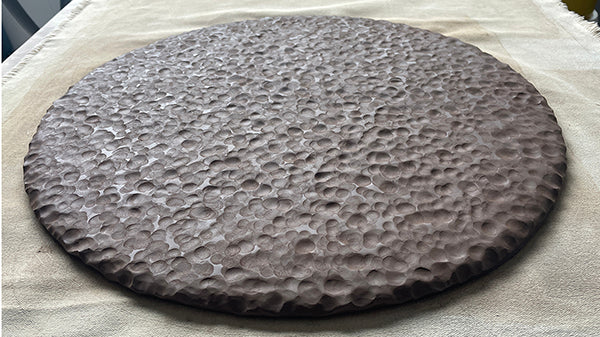Thank you Gardenista for featuring the new planters!
Margot from Gardenista sent me some initial questions (that I have copied with my answers below). It is always interesting to be prompted to articulate where inspirations come from and how they materialize in the making process.

Where does your imagery come from?
The root inspiration for my work is an ongoing thread from reading books on Eastern art, thought ad practices. Visual symbols of impermanence and connection are continual prompts that inspire and bring meaning to an expanding library of images, shapes and colors.
I love how direct the symbols of the sun, the moon and the stars are. Throughout the eons they have been a universally shared experience of living on this planet and an endless source of inspiration for writers, artists, scientists and thinkers. And to connect to all of that, we just have to look up.
Over time, some of the images in my work have been reduced to graphic symbols, shapes and color vibration. The ‘Domino’ in Marigold is a large full golden sphere paired with another large full white glazed circle, representing the passing of time from day to night, with a single star in between. The indigo version has a large very deep blue sphere, symbolizing the moon cycle from the dark new moon to the bright full moon.
For this collection of planters I focused the images on:
- The Sky (Wonder, awe, and expansiveness)
- Energy (Vibration, movement both opposing and in relationship)
- The Mountain (Ground, stability, and reaching)
What inspired you to make planters?
Plants! In both making and painting a vessel to house a living thing, the plant and planter become a kind of ‘object of devotion’. Just like the bells are in homage to the idea of transient sound and impermanence. It is in honor and gratitude to the beauty and life that plant organisms bring to this world.
What makes a perfect planter? How to pair your pots with the right plants?
I would say the perfect planter is one you like! My knowledge, unlike my appreciation, of plants and their needs is limited.
Currently I have 5 thriving house plants that are in front of the window where I drink my morning coffee. This is the most plants I have ever had and they bring me a lot of joy.

Also, here is a photo of one of the first things I made in clay (a planter) and had totally forgotten about. I had given it to a dear friend who passed last year and it recently came back to me. We had laughed at it and called it ‘My Mu’ which is a Japanese term for ‘no-thing’. We both loved it for the story and the process it held. Clay has that quality- to transform a moment or idea into stone.

There's a level of perfectionism in all your work that dazzles me--how do you do it?
Clay has a responsiveness and immediacy to it that people choose to approach in so many ways. When I first started taking classes at Greenwich House Pottery I would see people make ‘loose’ work, leaving the marks of the hand visible and obvious, even extreme. Sometimes I wished I made work like that, but you have to trust in your own process and make what YOU make, and not what someone else makes.
In my studio, we strive to perfect our craft and our ‘hand’ without overworking the material. Whether you are intentionally leaving your marks or trying to work with clean lines, clay can easily be pushed too far and feel forced. By repeating something over and over again, like throwing on the wheel, cleaning an edge, or painting stars, you gain a confidence and control while maintaining spontaneity. I think of it as similar to calligraphy, the freshness can only be brought through practice.
I'm looking for any info that inspires readers to stop and take a closer look.
Technical stuff: The planters are all thrown on the wheel in a custom groggy clay body that actually fires to a toasty brown. All of my work is covered multiple times with a white clay based material that fires to a matte slightly crackly surface. And in the gas reduction firing, the iron in the clay deepens creating a lot of variation and depth to the white.
In the planters, you find the hand in the throwing lines on the inside of the planters and in the catch plates. The larger plates are built by hand and we cut and shape the edges with minimal work to bring a raw, sculptural and stonelike quality to the planters.


